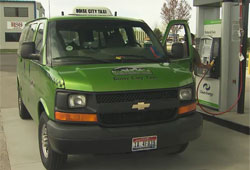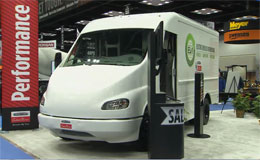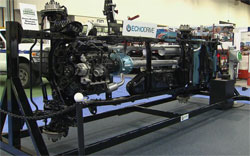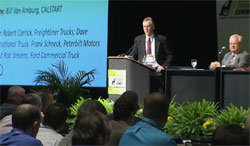Green Truck Summit
The new car auto show season is winding down, but we’ve added a big new stop to our tour this year. Indianapolis recently played host to the country’s largest work truck show, and gave us a firsthand look at how this vital industry is going green on a grand scale!
 While our attention is usually focused on the personal-use vehicle market, and the proliferation of hybrid and plug-in vehicles driving the green movement there, the work truck industry has been quietly staging a green revolution of its own, and can now boast a wide ranging portfolio of practical clean energy solutions that rivals and even exceeds that of light duty cars and trucks.
While our attention is usually focused on the personal-use vehicle market, and the proliferation of hybrid and plug-in vehicles driving the green movement there, the work truck industry has been quietly staging a green revolution of its own, and can now boast a wide ranging portfolio of practical clean energy solutions that rivals and even exceeds that of light duty cars and trucks.
It should be no surprise since local commercial and bus fleets and long-haul trucking have been a driving force in developing the national infrastructure for clean alternative fuels. Building stations to serve captive fleet customers makes the investment feasible and expands the availability of these fuels for light duty cars and trucks as part of the bargain. In addition to that, electric hybrids, hydraulic hybrids, and idle reduction systems have enjoyed great success and continuing development in the trucking industry.
 Packing the halls of the Indiana Convention Center from floor to ceiling are 500,000 square feet of work trucks and equipment. Every major truck maker and equipment supplier is represented here and every one has a clean-power story to tell.
Packing the halls of the Indiana Convention Center from floor to ceiling are 500,000 square feet of work trucks and equipment. Every major truck maker and equipment supplier is represented here and every one has a clean-power story to tell.
Patrick Davis, director of the vehicle technologies office at the U.S. Department of Energy, was one of those listening.
PAT DAVIS: Well what impressed me today was just the tremendous growth and the breadth of new technologies out there that you wouldn’t have seen two years ago. There’s just many more different types of technologies. Everything from natural gas, compressed natural gas, LNG, propane vehicles, electrification; you’re really seeing it all, and you’re seeing it in a lot more numbers than you were just two years ago.
 JOHN DAVIS: One key application on display at this show is retrofit-able hybrid power systems, allowing conversion of existing light and medium duty platforms to rechargeable hybrid battery power to assist in launching or driving the vehicle. Along with that, hybrid battery systems are being used to run truck accessories, like boom lifts, without idling the engine, increasing fuel efficiency, reducing emissions and promoting a safer, quieter jobsite.
JOHN DAVIS: One key application on display at this show is retrofit-able hybrid power systems, allowing conversion of existing light and medium duty platforms to rechargeable hybrid battery power to assist in launching or driving the vehicle. Along with that, hybrid battery systems are being used to run truck accessories, like boom lifts, without idling the engine, increasing fuel efficiency, reducing emissions and promoting a safer, quieter jobsite.
In the commercial world, dollars and cents drive every purchase decision, so clean fuels and technologies that can deliver increased efficiency, while reducing operating or maintenance costs will find a very receptive audience here. And this spirit of innovation has drawn new players into the field.
DOYLE SUMRALL: It’s really interesting because a lot of the people who came in with alternate fuels, and the technologies around those things, weren’t for the work truck industry. They might have been from the bus industry, or some other areas. And so, what we’ve seen is, as they’ve gotten to know one another and see the opportunities, the technology guys are explaining the technology to the work truck core people, they’re bringing the relationships, and building new businesses.
 JOHN DAVIS: The learning curve for fleet operators exploring this green new world can be daunting. So organizers of the work truck show have added an intensive series of educational seminars held in advance of the show opening. The green truck summit brings together top industry executives, truck manufacturers and fleet operators to share insights and solutions for implementing clean technologies into commercial vehicles.
JOHN DAVIS: The learning curve for fleet operators exploring this green new world can be daunting. So organizers of the work truck show have added an intensive series of educational seminars held in advance of the show opening. The green truck summit brings together top industry executives, truck manufacturers and fleet operators to share insights and solutions for implementing clean technologies into commercial vehicles.
And despite a little late-spring snow in Indy, a ride and drive event held outside the convention center proved quite popular. Attendees had the chance to take the wheel and experience the latest green rigs in real-world conditions.
The rate at which the truck industry has embraced clean alternative fuels and technologies is amazing, and holds great promise to keep on trucking towards a clean driving future.







